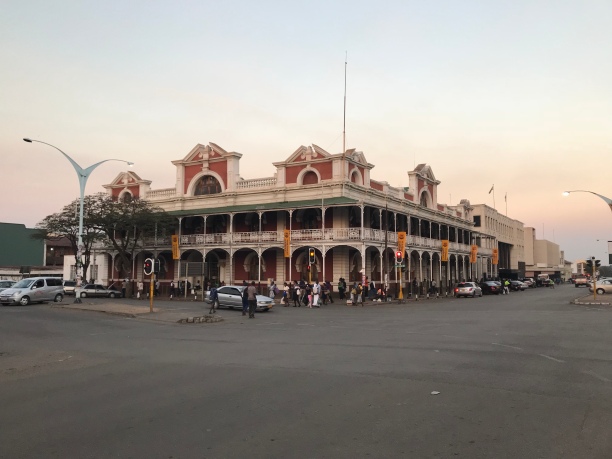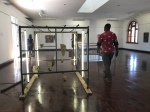The National Gallery of Zimbabwe in Bulawayo

The Gallery’s history dates back to 1970 at a time when local artists felt that they were increasingly isolated from the main institution in Harare. They lobbied and started their own gallery at what was then the Grand Hotel building. The National Gallery in Bulawayo attained its national status in 1994 when it moved to its current premises at Douslin House – a classic example of colonial Edwardian architecture. The Gallery operates under the Ministry of Youth, Sport, Arts and Recreation and its permanent collection reflects the diversity of cultures and traditions which have contributed to the development of art in Zimbabwe ranging from traditional artifacts to modern paintings and sculpture.
Apart from pursuing excellence in the visual arts in Matabeleland and maintaining general outreach, the Gallery sees it as their mission to encourage, train and develop artistic skills – especially for emerging artists.
In the beautiful courtyard and sculpture garden one thus finds a great number of studios where local artists can be witnessed at work. The gallery also houses a research library as well as various workshop facilities. In other words, The Gallery is a dynamic – and very intriguing! – meeting point for artists, patrons and the community.
We were welcomed by Silenkosi Moyo – administrator and P.A. to the Regional Director – and Jabulile Chinamasa – Conservation/Education officer – who took us on a tour in the galleries, which hosted various exhibitions by resident artists (Talent Kapadza and Jeu Verbre) as well as a major group show with Zimbabwean artists curated by Raphael Chikukwa (Lost & Found – Resilience, Uncertainty, Expectations, Excitement & Hope) that interrogates the social and economic fabric in the country in light of its most recent political transition. From a certain perspective the show is indeed mourning Zimbabwe’s turbulent history, but it also seems to mark a turning point while reaffirming at the same time the position of the artist as the primary storyteller. “A new glimpse of hope for the healing of the nation and for moving forward” as one reads from Chikukwa’s curator’s statement.
Afterwards we were also joined by Valerie Sithole (from The National Gallery of Zimbabwe in Harare), and Silenkosi and Jabulile provided generous information about the Gallery’s history and policies. A recurring theme was their emphasis on public programming, education and developing appreciation of the visual arts. Building partnerships is also very much on the agenda – both national and international, public and private as well as with NGOs. One of the serious challenges the Gallery is faced with is securing sufficient funds for conservation, acquisitions and operational costs, but loan fees and increased patronage from the private sector helps solve the problem to a certain extent. Furthermore, there is hope that recent developments in Zimbabwe’s administration will resuscitate the arts sector.
We then gathered with members of the artist community for a meet and greet which gave us an opportunity to learn more about their work. Also, the two artists in our group (Patricia and Farren) gave presentations. We were delighted that so many people showed up and shared their vision, which once again confirmed the tremendous generosity we’ve generally experienced on our trip, and it was only regretful that were not able to stay for long, but other appointments awaited.
Anders Gardboe Jensen
Mzililkazi Art & Craft Centre
Our next stop is the Mzililkazi Art Centr

How to experience the incredible art scene of Bulawayo in just one day? After the lively discussions at the National Gallery of Bulawayo with a full-packed room of local artists, Valerie planned for us a short but intense tour through various organizations, including three studio visits. Our first stop took us to the Arts & Crafts Center located in Mzilikazi, one of the oldest high density suburbs of Bulawayo. Established in 1963, the Mzilikazi Center is one of the oldest vocational arts and crafts institutions in the Southern part of Africa. Jabu tells us about the beginnings of formal art education in Zimbabwe and how it originated in the colonial era and in the context of the missionary schools founded by the Anglican church. Referring to Canon Paterson of the Cyrene Mission, Jabu tells us of the white Anglicans sympathizing with the black community through arts and music, installing a school within a black community in a time when they were not allowed to mix with the privileged whites. The Mzilikazi Arts & Crafts Center was not only built to foster professional art skills, but to empower unemployed school leavers and keep them off the street. Most of Bulawayo’s artists have since received their formal arts training at the Mzilikazi Arts & Crafts Center. Today the center functions under the municipal government of Bulawayo.
As opposed to the Bulawayo Polytechnic College, the center allows enrollment without academic qualification. Five disciplines are taught in a comprehensive 2-years training: fine arts (painting and drawing), commercial arts, ceramics, wood and stone sculpture, pottery and batik. Luckmore Muchenje, a former student and now a teacher for ceramics, guides us through the painting and drawing class, where we encounter a group of young students working with a wide range of techniques and motives. We move on to the pottery and ceramics class where two students demonstrate the crafting of pottery, their hands skillfully modeling the clay that is milled in their own school. After a six-weeks introduction into all disciplines, students can choose the discipline they want to specialize in. Mr. Muchenje tells us that fine arts is the most popular discipline.
Afterwards Mr. Ndiweni, who is in charge of the cleansing and selling of the ceramics products, takes us through the production spaces of the school as well as the school’s pottery shop. Whereas the products used to be marketed internationally, the arts industry has, like every other industry in Zimbabwe, been greatly affected by the country’s economic instabilities, and shifted more towards local markets. Mr. Ndiweni tells us that the pottery production is currently shut down for economic reasons with no funding to keep it running.
When I ask Luckmore Muchenje about the potentiality of adding a photography course to the curriculum, he tells me that even though there is great interest to include new media, the school currently has no funding for an expansion. Photography is still very absent in Zimbabwe’s art scene, in formal training and in actual practice. Most of the artists we encounter in Zimbabwe are painters and sculptors, among them Charles Bhebhe, who has exhibited at the Zimbabwe Pavilion at the Venice Biennale , as well as Tafadzwa Gwetai and Neville Starling, one of the very few artists we have encountered that work with the medium of photography.
So how to even begin to write about all of these tensions we’ve encountered on our trip? After all, we’ve only been able to scratch the surface of how the colonial and apartheid regimes continue to influence todays social (and mental) fabric, with many questions marks also with respect to how (western) capitalism will shape the current transitions taking place in the art world and throughout. The complexity of these issues can hardly be understood after just two weeks – despite the intensity and richness granted by the incredible (and incredibly humbling) privilege of meeting and speaking to so many inspiring and dedicated people in Cape Town, Johannesburg, Harare and Bulawayo. All we know for sure is that many of the personal stories, social realities and repressed voices remain to be told, disseminated, analyzed and heard as counter-narratives to the dominant history of the white colonial settler.
Doris Gassert
Bulawayo in one day: part three or is it four?
Not to be missed if you are trying to do all the important art venues in Bulawayo is the ‘Bulawayo Home Industries’. Located opposite of the Mzilikazi Art & Craft Centre it is a place which facilitates women in making a living. In a country where women emancipation is not as far as one should hope for, the Bulawayo Home Industries is an inspiring place. Manager Miriam Ndlovu shows us the premises.

Women as well as other unemployed people can enter the space and learn traditional skills to make all kind of articles. These articles are for sale on the spot as well in other places in Bulawayo. Annually there is also the Sanganai/Hlanganani Fair, an exposition for tourists where the pieces are on display and for sail. Part of the price is commission fee for the artist who made the piece. And the good news is: the centre is accessible for the women without having to pay for the facilities. The funding for the institute is by the Bulawayo City Council.
Annually 300 women make use of the facilities and adapt skills as weaving with cotton, wool and ilala palm. They make products as baskets, sandals, floor mats, floor rugs etc etc. At the end of the tour the group of course was tempted to make an investment. So I think all of us bought some souvenirs. But please don’t make the mistake to underestimate the dynamics of the place.

Bulawayo Home Industries is not only empowering women and conserves the traditional arts & crafts techniques, it is also a hidden gem for artists who are inspired by those techniques. So if you are an artist who is lingering on for instance weaving techniques … you might go to the Textile Museum in Tilburg (the Netherlands) but one could also consider flying to this place. Make a financial commitment to the place and in turn learn al about local skills and their hidden heritage. For sure manger Miriam Ndlovu would welcome you . Curious? Send her an email : byohomeinustries2034@gmail.com.
And off we went to our next stop. Never thought Bulawayo was such an inspiring place to be.
Annet Zondervan
We end the day with a diner










































I’d like to ask for permission to use your photo of the gallery, and who to give credit to.
LikeLike
Which picture do you want to use?
LikeLike
The first photo on this page: the street view image of the National Gallery of Zim, in Bulawayo. It’s a beautiful pic! And one of the only ones online that has a high enough resolution for my re-use purposes!
LikeLike
Please use it. I don’t have any idea who of the group made it. Just use it. For what will you use it?
LikeLiked by 1 person
It is for a talk I am giving on activism & art in Zimbabwe, at Queen’s University in Canada. I will cite the orientationtrip2018 website at the very least. Many thanks. 🙂
LikeLike
Thank you for asking btw!
LikeLike